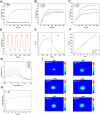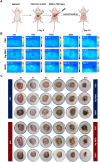A New Nanoplatform Under NIR Released ROS Enhanced Photodynamic Therapy and Low Temperature Photothermal Therapy for Antibacterial and Wound Repair
- PMID: 39071503
- PMCID: PMC11283834
- DOI: 10.2147/IJN.S471623
A New Nanoplatform Under NIR Released ROS Enhanced Photodynamic Therapy and Low Temperature Photothermal Therapy for Antibacterial and Wound Repair
Abstract
Purpose: Skin injury, often caused by physical or medical mishaps, presents a significant challenge as wound healing is critical to restore skin integrity and tissue function. However, external factors such as infection and inflammation can hinder wound healing, highlighting the importance of developing biomaterials with antibiotic and wound healing properties to treat infections and inflammation. In this study, a novel photothermal nanomaterial (MMPI) was synthesized for infected wound healing by loading indocyanine green (ICG) on magnesium-incorporated mesoporous bioactive glass (Mg-MBG) and coating its surface with polydopamine (PDA).
Results: In this study, Mg-MBG and MMPI was synthesized via the sol-gel method and characterized it using various techniques such as scanning electron microscopy (SEM), the energy dispersive X-ray spectrometry (EDS) system and X-ray diffraction (XRD). The cytocompatibility of MMPI was evaluated by confocal laser scanning microscopy (CLSM), CCK8 assay, live/dead staining and F-actin staining of the cytoskeleton. The antibacterial efficiency was assessed using bacterial dead-acting staining, spread plate method (SPM) and TEM. The impact of MMPI on macrophage polarization was initially evaluated through flow cytometry, qPCR and ELISA. Additionally, an in vivo experiment was performed on a mouse model with skin excision infected. Histological analysis and RNA-seq analysis were utilized to analyze the in vivo wound healing and immunomodulation effect.
Conclusion: Collectively, the new photothermal and photodynamic nanomaterial (MMPI) can achieve low-temperature antibacterial activity while accelerating wound healing, holds broad application prospects.
Keywords: immunomodulation; infection-related wounds; magnesium-doped bioactive glass; photodynamic therapy; photothermal therapy.
© 2024 Miao et al.
Conflict of interest statement
The authors declare that they have no known competing financial interests or personal relationships that could have appeared to influence the work reported in this paper.
Figures









References
MeSH terms
Substances
LinkOut - more resources
Full Text Sources
Medical
Miscellaneous

